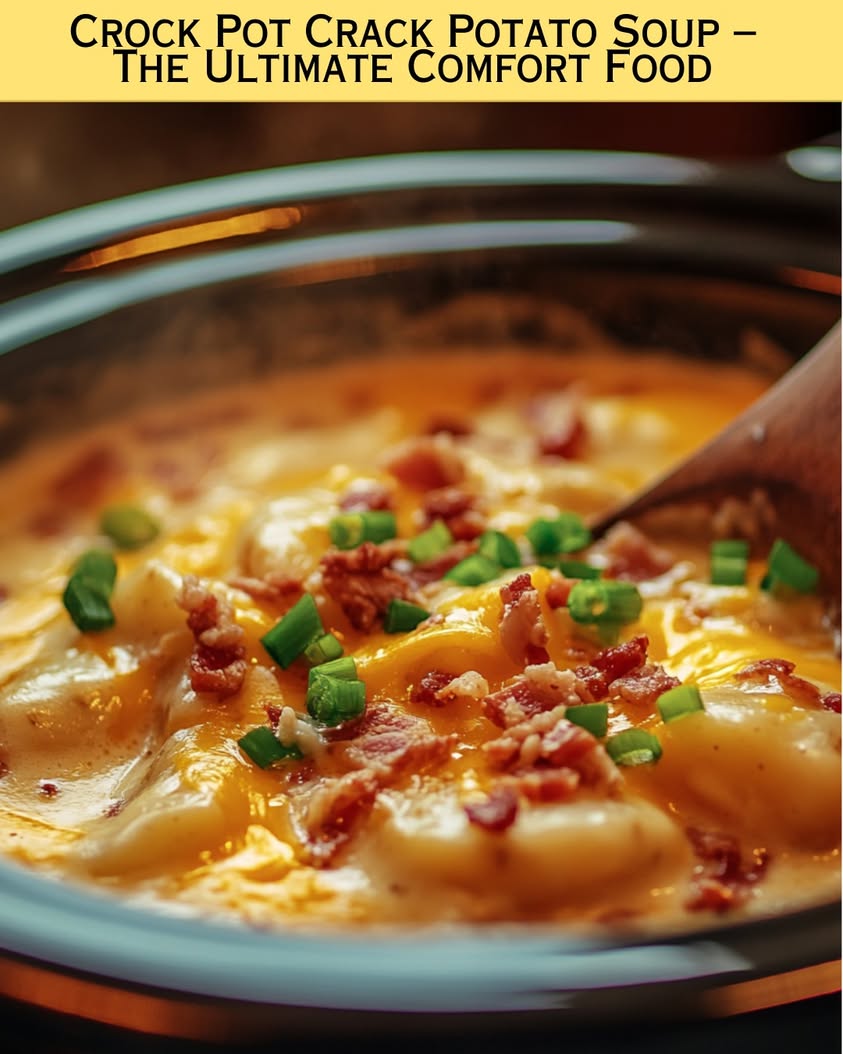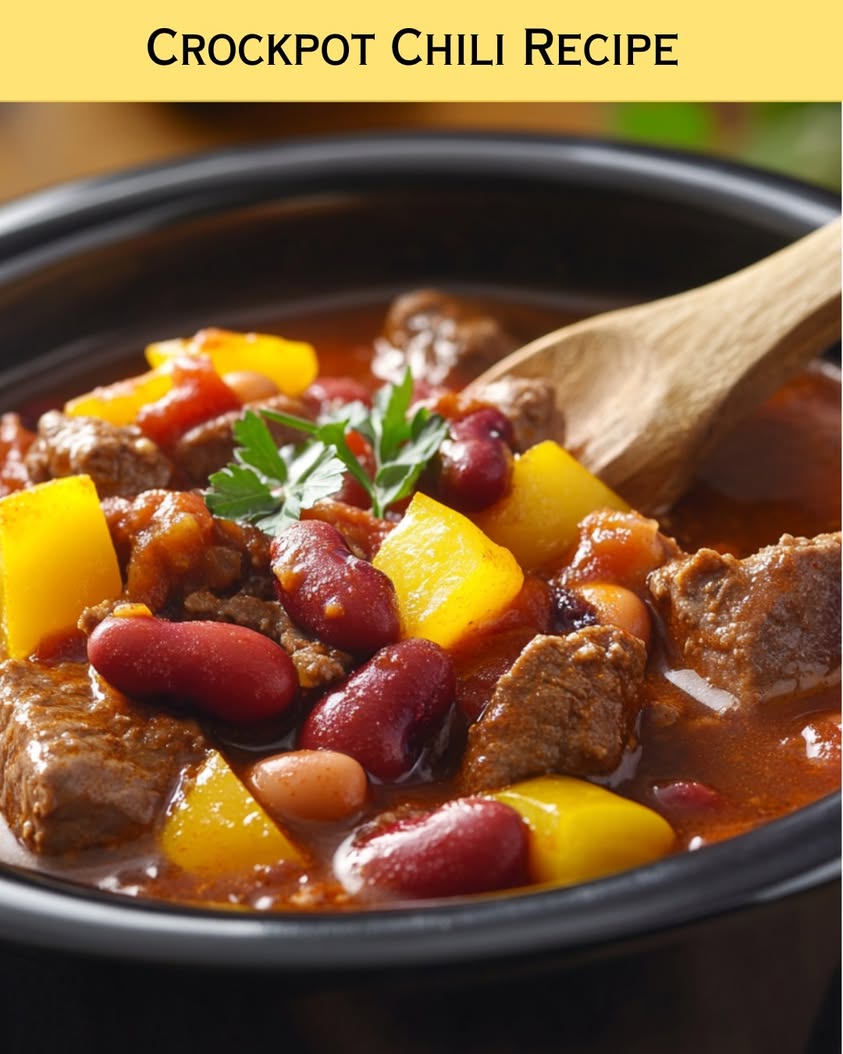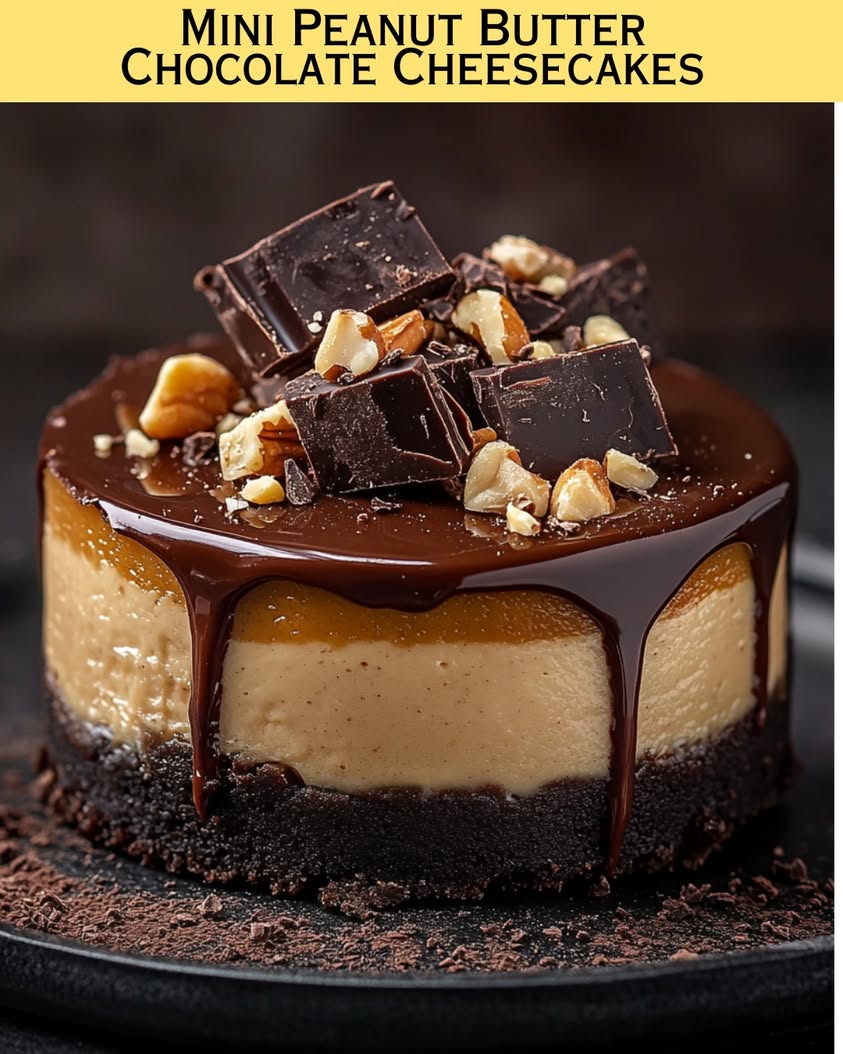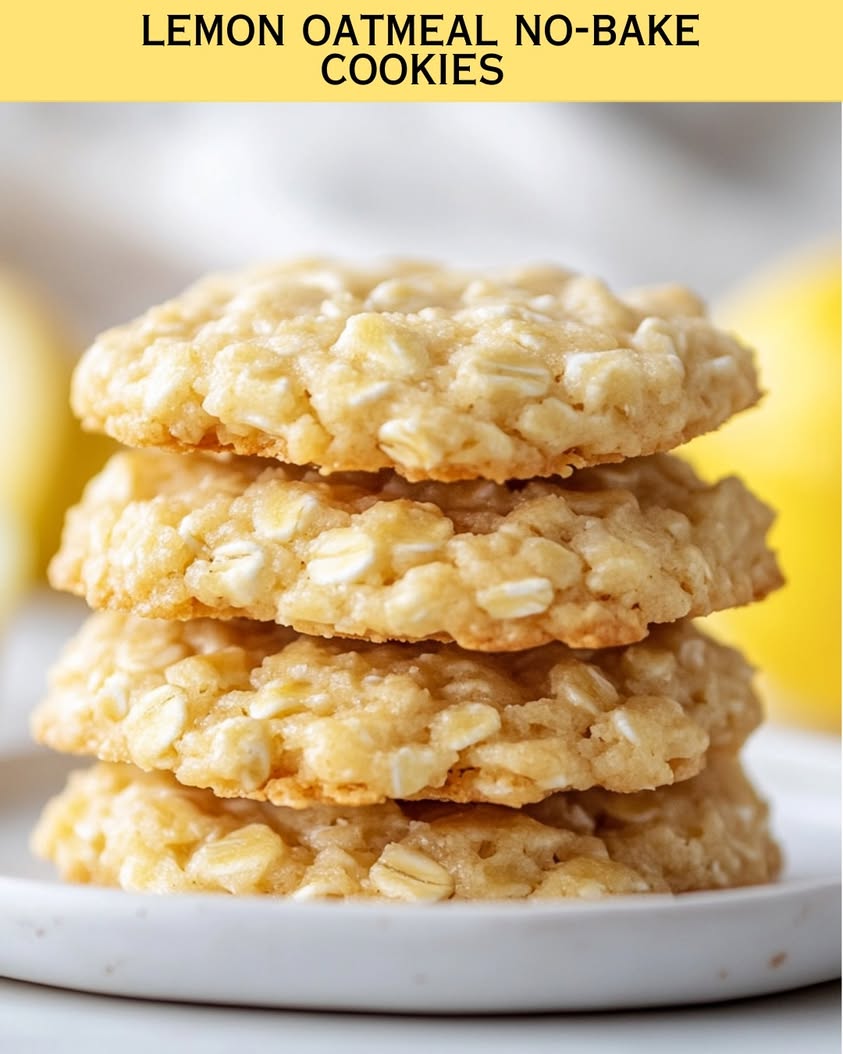Crock Pot Crack Potatoes: Effortless Comfort Cooking
Crock Pot Crack Potatoes are the ultimate comfort food that brings warmth and richness to any dinner table. Imagine tender potatoes soaked in creamy ranch dressing and topped with melted cheese, crispy bacon, and fresh green onions—it’s a dish that tantalizes the senses. The slow cooker does all the work, allowing you to enjoy a delicious meal without constant supervision. This easy-to-make recipe is perfect for busy weeknights or leisurely weekends when you want to spend more time with family and friends.
This dish combines simple ingredients for a taste explosion. The creamy texture of the ranch dressing melds beautifully with the potatoes, while the smoky flavor of the bacon elevates it to the next level. Each bite delivers a satisfying crunch from the toppings and a comforting warmth from the slow-cooked potatoes. Once you serve these hearty treats, your family will request them time and again, making them a staple in your recipe collection.
Quick Recipe Highlights
- Flavor Profile: Savory, creamy, and slightly smoky with a delightful tang.
- Texture: Creamy potatoes with a crispy topping create a satisfying contrast.
- Aroma: The inviting scent of bacon and ranch dressing wafts during cooking.
- Visual Appeal: Topped with golden melted cheese and vibrant green onions for a stunning presentation.
- Skill Level Needed: Perfect for beginner cooks and seasoned chefs alike.
- Special Equipment: Requires a crock pot for the ultimate cooking convenience.
Recipe Overview
- Difficulty Level: This easy recipe is perfect for everyone, featuring simple steps and minimal cooking techniques.
- Category: Ideal for side dishes, potlucks, and gatherings.
- Cuisine: A classic American comfort food with roots in traditional family recipes.
- Cost: Budget-friendly and easily adaptable to use leftover ingredients.
- Season: Perfect for any season, particularly as a hearty side dish in colder months.
- Occasion: Great for parties, family dinners, and casual get-togethers.
Why You’ll Love This Recipe
Crock Pot Crack Potatoes not only deliver incredible taste but also provide an unmatched textural experience. The creamy ranch dressing seeps into the potatoes, ensuring each bite is rich and flavorful. The cheese, when melted, creates a delightful gooey layer over the crispy bacon, making every serving irresistible.
The convenience of cooking in a crock pot cannot be overstated. Simply combine the ingredients in the pot, set it, and forget it! You can spend your time prepping other dishes or simply enjoying the day while this hearty side dish cooks to perfection.
From a nutritional perspective, potatoes are an excellent source of vitamins and minerals, offering fiber and important nutrients essential for health. The addition of green onions not only enhances flavor but also adds a dose of vitamins, making this dish a little bit guilt-free!
When hosting gatherings, Crock Pot Crack Potatoes are a crowd-pleaser. They are easily shareable, inviting your guests to dig into a communal dish. The combination of flavors and textures will spark conversations and compliments alike, making your event memorable.
In terms of cost-effectiveness, this recipe is an inexpensive, hearty option that doesn’t skimp on the flavor. It uses basic ingredients that are often already found in your pantry, making it approachable for any home cook or student on a budget.
Historical Background and Cultural Significance
The origins of Crock Pot Crack Potatoes can largely be tied to the rise of American comfort food, which has evolved significantly over the years. Classic American cuisine often incorporates hearty, filling dishes that appeal to families looking for inexpensive yet delicious meals to share.
Crock pots have revolutionized the way we cook, allowing complex flavors to develop over extended periods of slow cooking. This cooking method reflects a tradition of family gatherings where meals are prepared together and shared, celebrating togetherness.
As the recipe has evolved, variations have appeared that cater to different tastes, including the use of different kinds of cheese or spices. Over the years, the fundamental components have remained consistent, allowing Crock Pot Crack Potatoes to stay true to their roots.
Regional variations may often arise as families introduce their spins, whether it’s the type of cheese used or the addition of hot sauce for those seeking a spicy kick. Each version reflects the family’s culinary preferences and contributes to the dish’s growing legacy in American kitchens.
Ingredient Deep Dive
Potatoes are the star of this recipe, offering versatility and nutritional value. They are rich in potassium and vitamin C, which help boost immunity and provide energy. When selecting potatoes, opt for starchy varieties like Russets, which yield that fluffy, tender texture when cooked. Store them in a cool, dark place away from light to prevent sprouting.
Ranch dressing, while a seemingly simple ingredient, plays a pivotal role in elevating the dish’s flavor profile. Originating from ranch-style cuisine, this tangy dressing adds layers of taste that complement the potatoes. It contains herbs and spices that not only enhance flavor but bring additional ingredients into the mix, such as buttermilk for creaminess. When stored in an airtight container in the fridge, ranch dressing can last weeks.
Cheese is another essential ingredient that brings richness and depth to the dish. Cheddar is a popular choice because of its sharp flavor; however, feel free to experiment with Gouda or Pepper Jack for unique twists. Consider buying block cheese to shred yourself, as it melts more smoothly than pre-shredded varieties packed with anti-caking agents. Store cheese in the original packaging for the best longevity.
Bacon, when added to the recipe, introduces a smoky flavor that’s hard to resist. Opt for thick-cut bacon for a more substantial bite. Its savory notes beautifully contrast with the creamy potatoes. When purchasing bacon, look for fresh packs without a lot of water or gray appearance. For storage, keep in the fridge, but if opened, it should ideally be used within a week.
Common Mistakes to Avoid
- Adding too much liquid can lead to soggy potatoes. Stick to the recommended amounts in the recipe.
- Overcooking can result in mushy potatoes. Monitor timing closely, especially with smaller-sized cuts.
- Not seasoning properly. Always taste and adjust seasoning before serving for the best flavor.
- Layering ingredients incorrectly. For even cooking, place denser ingredients at the bottom of the crock pot.
- Skipping the browning of bacon can mean miss out on flavor depth. Sauté it beforehand for the best result.
- Using low-quality cheese may result in poor melting. Stick to high-quality cheese for optimal results.
- Ignoring the recommended cooking times can yield unappetizing textures. Follow timing guidelines for best results.
- Not allowing for rest time can affect texture. Let the dish sit briefly after cooking for improved consistency.
- Failing to properly clean the crock pot can lead to lingering flavors and sticking. Always follow cleaning protocols.
- Forgetting to garnish can dull the dish’s visual appeal. Fresh herbs or green onions enhance presentation significantly.
Essential Techniques
Using a crock pot requires understanding why it’s essential for many recipes, especially those needing long, slow cooking. The low heat method allows flavors to meld beautifully, resulting in dishes that have depth and complexity. Master this technique by knowing your appliance; ensure you use enough liquid to prevent burning and enhance flavor extraction.
Layering ingredients effectively is crucial for cooking success. Place denser items, like potatoes, on the bottom with lighter ingredients on top. This ensures even heat distribution and optimal cooking. This technique helps retain moisture and gives you that tender finish everyone loves.
Understanding timing in your crock pot is also essential. Always check your cooker’s settings and adjust accordingly. Knowing when to set your dish can save you from overcooked or undercooked components.
Gain familiarity with seasoning throughout the cooking process. Tasting and adjusting flavors as you go ensures that the final dish is well-balanced. Add salt and spices early and more delicate seasonings later on to preserve their nuances.
Pro Tips for Perfect Crock Pot Crack Potatoes
1. **For an extra crunchy topping**: Sprinkle some additional cheese and bacon during the final half hour of cooking. This helps to create that golden finish that everyone loves.
2. **Experiment with flavors**: Adding spices such as smoked paprika or garlic powder can elevate the dish’s depth, providing an unexpected twist.
3. **Layer flavors**: Consider sautéing onions and garlic before adding them to the crock pot. This enhances flavor complexity.
4. **Keep leftovers fresh**: Store any leftovers in airtight containers and refrigerate within two hours to maintain freshness.
5. **Customize toppings**: Try adding jalapeños or diced bell peppers to make it your own. Toppings make this dish diverse and adaptable.
6. **Consider the size of your potatoes**: Cut them into uniform sizes to ensure they cook evenly.
7. **Let it rest before serving**: Allowing the dish to sit for 10 minutes after cooking helps flavors settle and improves texture.
8. **Use full-fat ingredients**: For the best results, opt for full-fat ranch dressing and cheese, which will yield creamier results.
Variations and Adaptations
Crock Pot Crack Potatoes can easily be transformed to accommodate seasonal elements. Toss in roasted vegetables like zucchini or squash during summer months for a fresh twist.
Dietary needs can also inspire modifications, such as using dairy-free cheese or a vegan ranch dressing for a plant-based option. You can enjoy the beloved flavors without compromising dietary preferences.
Flavor-wise, spices can spice things up. Consider a BBQ twist by adding your favorite BBQ sauce and smoked sausage for a new take on this classic.
For texture modifications, mash half the potatoes before mixing with other ingredients. This yields a creamy base while leaving chunks for added mouthfeel.
Presentation alternatives can enhance the visual appeal; serve in a hollowed-out bread bowl or garnish with edible flowers during special occasions.
Serving and Presentation Guide
Presentation plays a key role in creating an appetizing dish. Start by using a large platter to display the potatoes, giving ample space for everyone to help themselves.
Garnishing is crucial; consider sprinkling fresh parsley or thyme for a dash of color. For an appealing finish, drizzle sour cream over the dish right before serving.
Traditional accompaniments, such as a green salad or cornbread, can balance the richness of the potatoes. These side dishes add freshness and layers of flavor to the meal.
Modern serving suggestions include individual ramekins for personal portions, enhancing the dining experience. This also aids in portion control for balanced meals.
Temperature matters: serve the dish warm, as it allows for the best texture and flavor. If you need to keep it warm for serving, use the “keep warm” setting on your crock pot for a seamless experience.
Wine and Beverage Pairing
For wine pairings, a buttery Chardonnay complements the creamy elements of the dish without overpowering its flavors. Alternatively, a light red like Pinot Noir adds a fresh contrast.
If you prefer non-alcoholic options, a sparkling lemonade or a crisp iced tea can beautifully cleanse the palate and balance the richness of the potatoes.
Coffee lovers might consider pairing with a mild roast coffee, served hot to enhance the comforting feel of the meal.
Temperature is essential; for wine, serve chilled while warm beverages should be hot but not scalding for optimal enjoyment.
To further elevate the dining experience, consider creating a signature cocktail using similar flavor profiles from the dish to promote harmony throughout the meal.
Storage and Shelf Life
Proper storage methods are essential for maximizing the shelf life of Crock Pot Crack Potatoes. Store leftovers in a non-metal, airtight container within two hours of cooking.
Keep the dish refrigerated at temperatures below 40°F. When stored correctly, the leftovers will last up to three days in the fridge.
Signs of spoilage include an off-smell, discoloration of the potatoes, or the presence of mold. When in doubt, it’s best to discard any questionable food items.
Reheating can be done in the microwave or on the stovetop. However, for best results, reheat gently on low heat, adding a bit of liquid to prevent drying out.
If you plan on freezing, ensure the dish is cooled and well contained to avoid freezer burn. Properly frozen, it can last up to three months, but be mindful of texture changes upon thawing.
Make Ahead Strategies
Planning ahead can streamline dinner prep. Prepping ingredients a day or two in advance can save time; chop the potatoes, cook the bacon, and prepare the ranch dressing mixture in advance.
Grocery shopping well in advance can also ease stress. Gather all necessary ingredients and have them ready for assembly on cooking day.
When following the prep timeline, remember to check your slow cooker’s timing to ensure that everything aligns smoothly.
To maintain quality, keep ingredients separated until it’s time to assemble them in the crock pot. Store everything in the fridge until you’re ready to cook.
For reheating, remember to add fresh elements after defrosting, such as green onions or parsley, to maintain the appealing presentation and freshness.
Scaling Instructions
Scaling the recipe is straightforward. To halve the recipe, simply divide all ingredients and cooking time to create smaller portions without losing flavor.
If doubling or tripling, make sure your crock pot can accommodate more volume, or consider splitting the recipe into two separate pots.
Timing modifications may be necessary when scaling; for larger quantities, a longer cooking time could be needed. Adjust according to how many potatoes you add to maintain texture and flavor throughout.
Storing considerations increase with larger recipes. Use multiple containers or vacuum seal bags in the freezer to maintain freshness.
Don’t forget about ingredient availability—check your pantry to ensure all items are on hand before beginning your cooking process.
Nutritional Deep Dive
The macro breakdown of Crock Pot Crack Potatoes includes essential carbohydrates and fats from cheese and ranch dressing. Each hearty serving provides energy while supporting daily nutritional needs.
Micronutrient analysis shows potatoes as a potent source of potassium and vitamin C; these nutrients are crucial in promoting bodily functions including immunity and muscle function.
The health benefits of this recipe can include increased satiety from fiber-rich potatoes, contributing to a feeling of fullness, which may assist in weight management.
In producing balanced meals, be mindful of portion sizes; this will help prevent overindulgence while still enjoying the rich flavors.
To incorporate this dish into a weight management plan, consider pairing with a salad or light protein to make your meal more balanced.
Dietary Adaptations
For gluten-free variations of this recipe, ensure all ingredients, including ranch dressing and any toppings, are certified gluten-free. Substituting certain dressings or sauces can accommodate those with gluten sensitivities while preserving flavor.
Dairy-free options abound too; use dairy-free cheese and plant-based ranch dressing to create a vegan-friendly version while maintaining the heartiness of the dish.
For a low-carb variant, consider swapping potatoes with cauliflower to reduce carbohydrates dramatically, creating a similar texture and flavor when mixed with the other ingredients.
A keto adaptation might incorporate cheeses high in fat while reducing the potato content further, complemented with spices to keep bold flavors present.
Paleo-friendly versions could eliminate dairy altogether while choosing wholesome ingredients, ensuring it aligns with paleolithic dietary principles.
Troubleshooting Guide
If you encounter texture issues, such as overly mushy potatoes, reduce cooking time or consider cutting them larger. Avoiding overcooking can help maintain that perfect bite.
When balancing flavor, remember to taste before serving. If it lacks flavor, a pinch of salt or a splash of vinegar can elevate the dish’s profile significantly.
Temperature problems may arise from overcooking; a good rule is to check the tenderness of your potatoes: they should be fork-tender, not disintegrated.
For challenges with equipment, ensure your crock pot is functioning properly. The temperature setting should reflect the required cooking time; use a thermometer to ensure accuracy.
If you face ingredient substitutions not performing at par, always look for alternatives that mimic the flavor and texture—this could make all the difference in vital dishes.
Timing concerns can affect serving quality; compare other recipes for extracts on how to best navigate your schedule with multiple dishes on the go.
Recipe Success Stories
Community feedback for Crock Pot Crack Potatoes has been overwhelmingly positive, with many praising their simplicity yet satisfying flavors, making them a favorite amongst families.
Variation successes include adding different spices and roasted vegetables, showcasing the adaptability of the dish without losing core flavors, resulting in rave reviews at potlucks.
Readers have suggested ways to enhance the photography of the dish by adjusting lighting and using colorful plating, emphasizing that visuals can indeed affect appetites.
Sharing can bridge gaps between cooks; many find creative twists from other cooks invaluable in enhancing their attempts at familiar recipes.
Engagement within the community often inspires further recipe development, leading to innovative variations that keep the dish relevant and exciting.
Frequently Asked Questions
Can I make this recipe vegetarian?
Absolutely! You can easily omit the bacon and use vegetarian bacon substitutes, while ranch dressing can be swapped for a plant-based version to keep it meat-free.
Can I use frozen potatoes for this recipe?
Using frozen potatoes is usually not recommended, as their texture may become overly watery. Fresh potatoes will always yield the best results in this dish.
How can I store leftovers?
Store any leftovers in an airtight container in the fridge. They should remain good for up to three days. Always reheat gently to retain their texture.
Is it possible to double the recipe?
Yes! Just ensure your crock pot is large enough to handle the increased volume and adjust the cooking time if necessary to account for additional ingredients.
What can I serve with Crock Pot Crack Potatoes?
This hearty dish pairs wonderfully with salads, grilled meats, or even as part of a buffet spread for gatherings, providing a comforting side to various main courses.
Can I add different types of cheese?
Absolutely! Feel free to experiment with different cheeses like Gouda or Pepper Jack for added flavors. Each type of cheese will lend different textures and delightful tastes.
How long does this recipe take to cook?
This dish cooks for about 8 hours in a crock pot, making it perfect for low and slow cooking while you go about your day!
Can I use less cream in this recipe?
Yes! If you’re looking to reduce calories or fat, feel free to use a light ranch dressing or decrease the cheese amount to your desired level.
Is it safe to leave the crock pot on overnight?
Yes, it is safe to use your crock pot overnight. Make sure it’s on a stable, even surface and follow the instructions for your specific model.
Can I freeze this dish?
Yes! Once cooled, you can freeze the dish in airtight containers. Just be aware that the texture may change when reheating after freezing.
Additional Resources
For those looking to enhance their cooking repertoire, explore related recipes that focus on comfort foods. This includes traditional slow-cooked dishes or casseroles that bring warmth and satisfaction.
Technique guides can help improve your overall cooking skills. Learning how to use your crock pot efficiently, as well as mastering slicing vegetables and seasoning methods can make a difference.
Information on specific ingredients can also elevate your cooking game. Explore the nutritional benefits of whole foods and how they contribute to balanced meals.
Equipment recommendations are key for anyone venturing into slow cooking. Invest in a quality crock pot or slow cooker based on your cooking habits, ensuring long-term satisfaction and use.
Seasonal variations could inspire your next recipe whisk. Incorporating seasonal vegetables can not only improve flavor but aesthetics, resulting in a more engaging meal.
Join the Conversation
We encourage you to share your experiences making Crock Pot Crack Potatoes on social media! Tag us to showcase your delicious creations, and don’t forget to share any variations you’ve tried.
Photography plays a huge part in food blogging. Heighten your food photography skills by adjusting lighting and angles to capture the elegance of your dish.
Your reviews matter; provide feedback and suggestions to improve our recipes, allowing us to connect with you and make enhancements based on your needs.
Engagement within our community fosters excitement and motivates fellow cooks to try new things, creating an enthusiastic atmosphere for sharing cooking adventures.
As you create and adapt recipes, remember to interact with other cooks to exchange culinary ideas. Your unique combinations may inspire others!
The Recipe
Crock Pot Crack Potatoes
Serves: 6 servings
Prep Time: 15 mins
Cook Time: 8 hours
Total Time: 8 hours 15 mins
Kitchen Equipment Needed
- Crock pot
- Cutting board
- Sharp knife
- Measuring cups and spoons
- Mixing bowl
- Spatula
Ingredients
- 3 lbs potatoes, cubed
- 1 cup ranch dressing
- 1 ½ cups shredded cheddar cheese
- 1 cup bacon bits
- ½ cup sliced green onions
- Salt and pepper to taste
Directions
- Prepare the potatoes by washing and cubing them into small pieces. Place them at the bottom of the crock pot.
- In a mixing bowl, combine ranch dressing, salt, and pepper, and stir until well mixed. Pour over the cubed potatoes.
- Layer half of the shredded cheese on top of the potatoes, followed by half of the bacon bits.
- Repeat these layers with the remaining potatoes, ranch mixture, cheese, and bacon.
- Cover and cook on low for 8 hours or until potatoes are fork-tender.
- In the last 30 minutes of cooking, sprinkle remaining cheese on top and cover to allow it to melt.
- Once finished, top with freshly sliced green onions before serving.
Recipe Notes
- Consider using different types of cheese for varied flavor profiles.
- Feel free to add additional vegetables for a nutritional boost.
- This dish can be customized for different dietary needs easily.
- Make sure to store leftovers properly to enjoy them for a few extra days!




